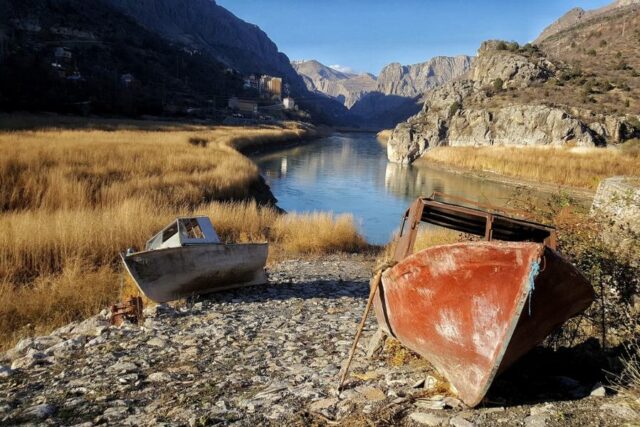How many times has the Euphrates River dried up? The Euphrates River flows through Iraq, Syria, and Turkey.
For over 10,000 years, this river has supplied most of the region’s water. Nevertheless, as of late, it has started to dry up due to aridity and climate change that accelerates the drought.
Researchers predict that if the Euphrates continues at this rate, it will dry up eventually. It is among the oldest and most prominent rivers on the planet.
Why is the river experiencing difficulties with the water levels lowering? Why is the Euphrates River this important? Continue reading to discover the cause and significance of the Euphrates River drying up.
How Many Times Has the Euphrates River Dried Up
The Euphrates River has never dried up; however, the water level has fluctuated significantly. The drop in water levels in the Euphrates has contributed to the ongoing drought in the area.
Research shows that between 2003 and 2013, the Tigris and Euphrates River systems lost approximately 34 cubic miles of freshwater, as visible from space imagery. As a result, the river recorded the lowest levels ever.
The Euphrates River Explained
The source of the Euphrates and Tigris rivers is in northeastern Turkey. Flowing in a nearly parallel direction, the rivers traverse the southern border of Turkey before merging and emptying into the Persian Gulf via Syria and Iraq.
These two rivers, which have supplied vital water sources for human beings since the early days, are responsible for the region’s comparative fertility in an ordinarily arid region.
The Euphrates is approximately 190,000 square miles in extent and 1,700 miles in length. The river is the longest in Western Asia. It is home to numerous species, including fish, reptiles, and small and large mammals.
There are also several wildflowers and plants. The snake species that inhabit the Euphrates River in abundance include Persian sand vipers, Levantine vipers, desert black vipers, beaked sea snakes, and yellow sea snakes.
Riverbank vegetation comprises lush willow trees and untamed grass. You may also encounter feral pigs, shrews, river otters, wolves, and hedgehogs drinking from the river.
The water level typically rises from April to May due to increased rains and snowmelt. Natural vegetation is still visible along the riverbank. The Euphrates River traverses xeric forests situated in the mountainous region of Southeast Turkey.
Along the river’s bank are an assortment of vegetation and trees, including plum and rose trees, pistachio trees, and oaks. Cereal goods such as wheat, rye, and oats are prevalent in arid regions.
The region encompassing these two rivers was formerly integral to the Fertile Crescent. An agrarian-friendly area that ultimately supported the development of early civilizations, including Mesopotamia.
The Euphrates River is Drying Up Due to Climate Change
The Tigris-Euphrates river system is rapidly drying up in a once highly fruitful region. Climate change and drought are the cause of the drop in water levels. The Iraqi Ministry of Water Resources projected in 2021 that the rivers could run dry by 2040.
In just a few decades, the flow of the Euphrates-Tigris River system during dry years has decreased to nearly half of what it once was.
Space imagery indicates that the Tigris and Euphrates River basins experienced a freshwater loss of 144 cubic kilometers (34 cubic miles) between 2003 and 2013. As a consequence, certain water levels reached their critically low points.
The precipitation and snowfall that typically supply the rivers with water have been steadily and abruptly declining, resulting in the current drought. This climate issue has significantly worsened due to excessive water extraction and poor water management.
Like numerous significant rivers worldwide, the Euphrates has been dammed at various junctures along its course. A predicament that wreaks havoc on the inhabitants situated further downstream who rely on its water.
This has led to regional conflicts comparable to those between nations that share rivers such as the Nile and the Mekong.
Much of this is attributable to the global climate catastrophe. The Middle East is widely believed to be among the regions most significantly impacted by climate change. This is likely to worsen the water issues in the area.
Bad news for the environment means individuals in the surrounding area will feel the impact. The Euphrates-Tigris River system supplies water to approximately sixty million people, primarily in Iraq and Turkey.
International cooperation on managing the Tigris-Euphrates Basin has reportedly ceased since the 2000s. The circumstances above have led to regional competition and geopolitical concerns among stakeholders in the river system.
Besides being breathtaking, the Euphrates River is also historically significant. Historically prosperous cities were along the river, including Shuruppak, Mari, Urkuk, Nippur, Ur, and Sippar. Water meant power. It provided arable land for farming in areas along the riverbed.
The earliest documentation of the Euphrates River arrives in cuneiform scripts discovered in pre-Sargonic Nippur and Shuruppak. It dates to around 3000 BCE.
Sumerians referred to it as Buranuna. The river’s name is identical to that of the ancient metropolis of Sippar in present-day Iraq. Regarding religious significance, the metropolis and the river likely shared a connection.
In the next century, there may be numerous “water conflicts” in which states and militias vie to access water sources.
Such conflicts are probable in numerous locations across the globe. The Tigris-Euphrates complex is challenging due to its dense population and persistent political instability.
In addition to the possibility of conflict and violence, illness is a significant issue.
A March 2023 article in the British Medical Journal examined how the lack of access to pure water in Iraq is causing a multitude of health issues among the population. Cholera, measles, cholera, and typhoid are all water-borne diseases common in the area.
People have been concerned about the potential drying up of the Tigris and Euphrates rivers ever since the time of the Bible. These concerns may shortly come true despite the passage of thousands of years.
Drying River Threatens Conditions in Syria
The inhabitants of northeastern Syria are highly reliant on the Euphrates River; they consider it to be the region’s lifeblood.
However, the decline in water levels has impeded people’s access to pure drinking water, energy, and water for agriculture. Additionally, it has jeopardized food security and stockpiles.
Due to the river’s decreasing flow and low water levels, the water has become more toxic, providing an ideal environment for spreading disease and the occurrence of cases.
The decline in water levels from the Euphrates River has impacted the health, environment, and economy of the Autonomous Administration of North East Syria (AANES).
This is according to Imad Obeid, an employee of the Dams General Administration and an employee of the AANES.
The scarcity of water from Turkey has posed challenges in electricity generation and contaminated potable water, thereby contributing to the transmission of diseases and outbreaks of epidemics. He forewarned of “a genuine catastrophe for humanity.”
In 1987, with the assistance of the United Nations, Turkey, Syria, and Iraq reached an agreement allowing Syria to utilize 500 cubic meters per second of the Euphrates River.
“However, Turkey has halted the passage of the agreed-upon quantity of water for approximately two years,” Obeid stated. “This necessitates that the Dam Administration withdraw water from the lakes’ strategic reservoir.”
The current water discharge rate is below 250 cubic meters per second due to evaporation, agriculture use, and consumption.
He stated that evaporation depletes the Euphrates Lake of 80 to 100 cubic meters of water every second during the summer.
Turkey’s retention of Euphrates River water from other nations violates the United Nations Convention on the Regulation of Cross-border Rivers and Water Borders.
International agreements endorsed by the United Nations mandate that the upstream nation of a transboundary river must transfer a specified volume of water to the midstream and downstream nations.
Since they signed the agreement in 1987, however, Turkey has continued to restrict water flow however it pleases, disregarding health concerns.
Turkey has historically employed the Euphrates River as a strategic weapon against Syria. It considers it theirs and perceives it as a more productive approach than warfare.
End Time Prophecies on The Euphrates River Drying Up
As predicted in the Bible, the Euphrates River is now on the verge of drying up. The root causes of this issue are persistent droughts and climate change, not supernatural concepts such as the end of the world.
The Euphrates River has historically been a component of the Fertile Crescent. It is an essential resource in the Middle East and a biblical symbol. The water level of the Euphrates River has decreased significantly over the past few years.
With the Euphrates River dropping in level. Several ancient caves and ruins are visible. Some individuals consider the desiccated riverbed evidence of the biblical prophecies regarding the world’s end.
Two biblical texts talk about the drying of the Euphrates River. The first is a text against Babylon, where judgment is passed to its officials, wise men, and false prophets. God says in Jeremiah 50:38
“A drought on her waters!
They will dry up.
For it is a land of idols,
idols that will go mad with terror.”
About the passage, the waters of Babylon are Euphrates and Tigris. Is Jeremiah’s prophecy becoming a reality?
Conclusion
How many times has the Euphrates River dried up? Climate change, including droughts, storms, and extreme heat, has devastating effects and affects daily life.
Among other issues, water level fluctuations can facilitate disease transmission. Furthermore, the drying up of the Euphrates River in Western Asia endangers the societies that rely on it.
Why should individuals be concerned about the Euphrates’ water loss? The Euphrates drying up means millions of people in the Middle East will lack water, which is life. We can help avoid this by changing how we use energy and creating awareness of global warming.














